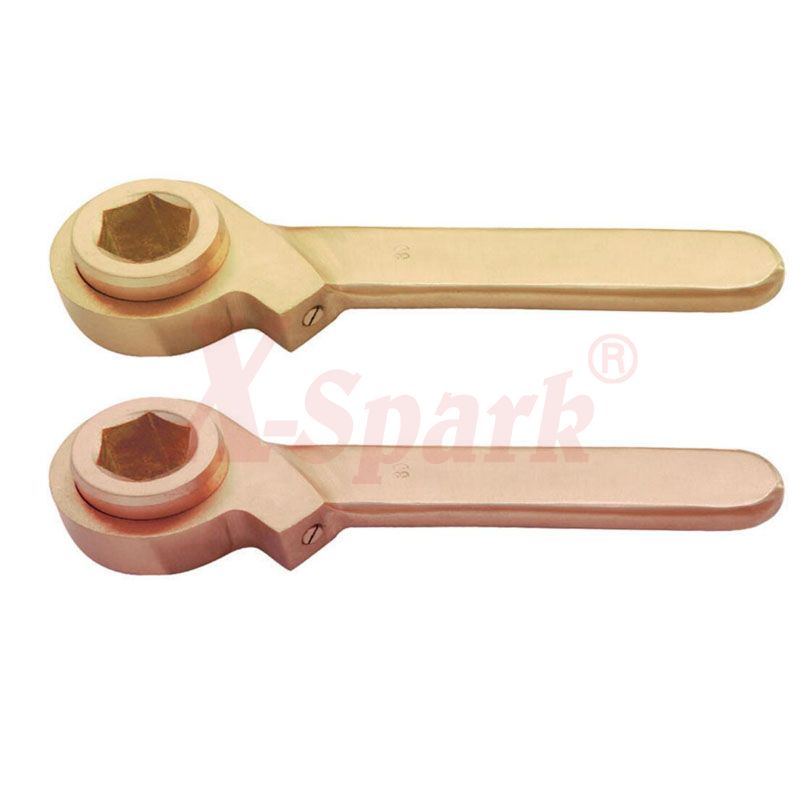When And How To Use Non-Sparking Tools
If you're a professional working in the oil and gas industry, you know that it's important for you to choose a specific hand tool that minimizes the risk of workplace accidents.
What is a non-sparking safety tool?
Non-sparking or safety tools are very different from the conventional hand tools commonly used in the toolkits of mechanical shop professionals. In fact, the conventional manual tools, such as a wrench, usually made from high strength of chrome vanadium steel alloy, this material is not suitable for use in the potentially explosive environment of equipment: in fact, if the steel wrench will drop in such an environment, it may produce a spark, causing explosions or fire, thereby endangering platform on all of the workers' life.

This is why you need special tools made of bronze, aluminum, beryllium, nickel, and copper alloys in areas where flammable gases, dust, or liquids may be present (ATEX areas). All the alloys used to produce this particular type of tool have lower tensile strength than traditional materials: this means they have less strength and resistance, are softer and wear out faster, but produce less heat, and a cold spark at low temperature cannot ignite anything.
In fact, the copper and beryllium alloys of explosion-proof hand tools ensure maximum safety even in extreme situations, even in subtle situations, and where even a single spark can be fatal.
How to use the explosion-proof hand tool?
The basic principle of the recommendation is to always ensure that all non-sparking tools are thoroughly clean and free of rust or iron contaminants, which may invalidate the deflagration resistance of non-sparking tools. Then, you must always remember not to put them in direct contact with acetylene, which in the presence of water produces a highly dangerous explosive acetaldehyde. Third, we must always keep in mind that all non-sparking tools are regularly polished in accordance with normal safety procedures to protect the eyes and face and to use appropriate tools to collect the powder. Finally, it is crucial to ventilate the building to remove potentially harmful powders and vapors from the air.
By following a few simple rules, you will ensure that you always have clean and fully functional tools and minimize potential hazards in the workplace.
Safety tips to keep in minds while using the non-sparking tools
Given below are safety tips for using non-sparking tools properly and keeping them in mint condition:-
#1)Maintaining cleanliness
These tools must be kept clear of any unwanted particle deposits and dust. A lot of times, residues get settled on the ends of the non-sparking tools; these deposits make the tools even more prone to producing sparks, triggering fires or explosions as a result.
#2)Overall maintenance
Non-sparking tools are fragile equipment because of their exceptionally high levels of softness in comparison with that of the steel hand tools. Thus it is important to use these tools lightly and maintain them from time to time.
#3)Cross ventilation
Dust is almost always present in places where the air is stagnant and does not get a passage to go in and out from. In the presence of dust, explosions in vulnerable environments are commonplace.
#4)Crucial checks
Monitoring the environment proactively from time to time is another thing that can ensure that a potentially hazardous situation hasn’t developed.
#5)User manual is the Bible
All devices come with a user manual. The best thing to do before using any equipment is to go through it thoroughly and act only as per that.
What if you don't use non-sparking tools in a dangerous environment?
As we explained in the previous question, in some environments, standard hand tools can lead to the creation of sparks that endanger the lives of all workers in the facility.
Take an offshore oil rig for example: in such a place, there may be gas or liquid substances that could cause a fire or explosion. In this case, it is unthinkable to use a traditional hand tool. Instead, use tools that do not contain ferrous metal.
Friction ignition can occur when tools are dropped or rubbed against materials such as cement: in fact, steel alloys attached to chromium-vanadium produce thermal sparks and are at high risk because they can ignite combustible substances in the air. For a moment. This can cause a fire or explosion, endangering the lives of everyone in the workplace.
We are a non-sparking tool supplier. If you are interested in our products, please contact us now!

Comments
0